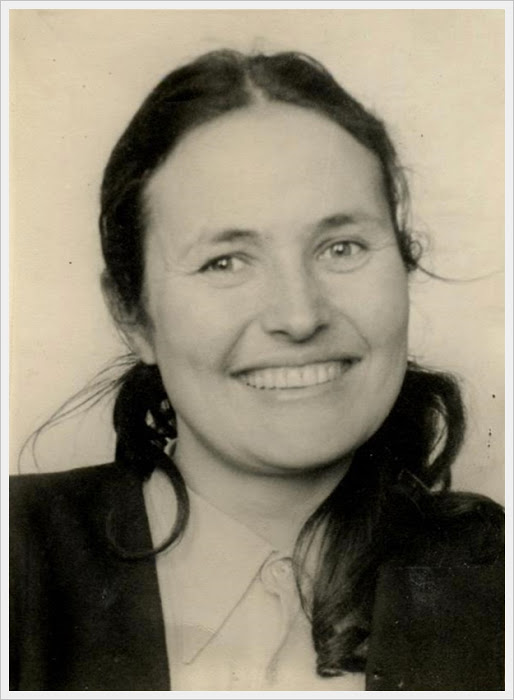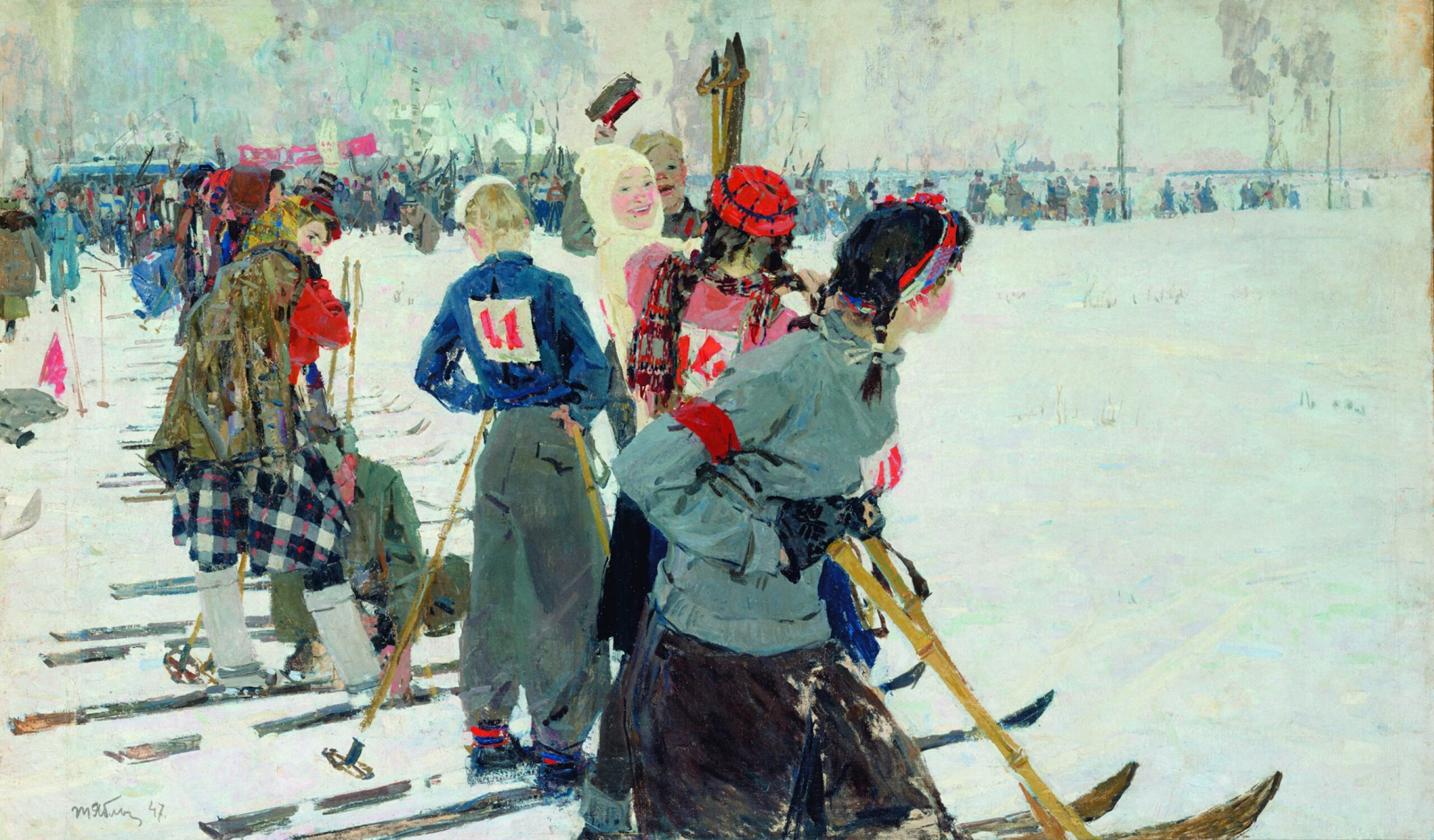

– born 1917 in Smolensk, Russian Federation, died in 2005 in Kyiv, Ukraine – the Soviet-Ukraine female artist, painter. Studied in the studio of Fedir Krychevskyi at the Faculty of Painting of the Kyiv Art Institute (currently, the National Academy of Fine Arts and Architecture). During 1947-1973 she was a professor at the Kyiv State Art Institute. Yablonska is a holder of many Soviet and Ukrainian state awards, in particular 1998 she was awarded the National Taras Shevchenko Prize of Ukraine, and in 2001 – the title of Ukraine’s Hero. In 1956, her painting “Bread” (1949) dedicated to the women’s labor of the Ukrainian peasants, was displayed, among other works, at the Venice Biennale inside the Soviet pavilion. In the 1960s, she produced a series of paintings that were inspired by folk art. Most of her works are stored within the museum collections of the Russian Federation and Ukraine.
About myself
Everyone wonders why in the 1960s I suddenly and steeply turned to the left, to the ethnographic decorativeness, and now returned back to the “traditional” painting? Why did I move back and forth? That’s what I think about it.
Before the war, while studying at the Institute, I worked long and hard on painting. Just painting. I began to fully comprehend the meaning of a tone and the integrity of a living painting surface, the materiality of color, as well as the transmission of color and space environment. In one word, I began to master the rich arsenal of the painting language. The war prevented me from establishing my positions in painting. More than a three-year break rapidly pushed me back. All the subtleties of sensing a painting were lost. One should have worked hard and close on life-painting again in order to revive this forgotten sensing, but at that time I could not deal with this any more. With the studies. Post-war uplifting, youthfulness, self-confidence, large number of plans. One painting went after another. One success after another.
However, in some of my works, I gradually began to restore the forgotten feeling of sensing a painting. Mostly in my painting Before the Start1. It was through painting, through paint, that I wanted to convey the freshness of clean winter air and the radiance of young faces. I remember that I wanted the entire canvas to achieve the effect of a delicately velvet surface, so that the feeling from observing it would resemble the feeling from touching a frosted and cold-fresh young girl’s cheek subtly covered with a light fluff. It was the same feeling forgotten during the war about the pictorial unity, pictorial materiality which I aspired to achieve in the Institute’s settings. This feeling was still timid and subconscious. It was backed neither by an opinion, nor by artistic experience.
The painting Before the Start, as they usually say, caused a stir at one of the post-war all-Soviet exhibitions. It was even nominated to receive a state award. I was already approached by reporters and photographers. The official announcement was about to be issued. It seems like everything was confirmed. And, out of a sudden, there was a 180-degree U-turn: resolution on Zvezda and Leningrad journals, Muradeli opera. Zhdanov’s letter, a strike on “formalism”. Devastating strike that shook even the strongest heads, not mentioning mine. It shook even the mighty man Deineka, even Serhii Herasymov, even Favorskyi. Not to mention me – a very young woman who has just embarked on an independent journey? I was not completely shaken off my path, I was still holding!
The painting Before the Start was removed from the frames, for a long time it laid around in the basements of the Ukraine’s Museum of Art. So, instead of the award, the painting enjoyed some abusive epithets. Something along the lines of “relapse of formalism or impressionism” and so on. It was funny, but still a fact. And all my paintings and sketches – them too. “Talented, but…” These “buts” were everywhere.
Serhii Hryhoriev who previously said: “We, the left…” turned to the right precisely 180 degrees. The “witch hunt” was launched in the Institute. At the department, my paintings as well as the ones of Oleksii Oleksiyovych Shovkunenko were heavily criticized for their impressionism. Disgust. Students could not even be referred to impressionism. And how Helman got some! For showing the students a wonderful book about Rodin! Not about Bourdellel, or at least Maillol, but about Rodin! A new concept emerged called “foot landscape” which means a naturalistic depiction of all the landscape’s smallest details in the foreground. It is unbelievable that it all happened! It is a pity that no one kept a diary!
This all worked, of course. Like it or not, but this was the Stalinist era. But I was not completely scared. I was saved by my love for life and passion for it.
(…)
And the “thaw” kicked off. The cult of personality got debunked. The revival of art began. I felt like a dead end with my paintings on the “children’s theme”. I felt the need for active artwork. Zakarpattia and its highly interesting painting school helped. How fresh were the artworks of Erdeli, Kotska, Manailo, Sholtes, Hliuk, Bokshai!
(…)
The fascination of the national form in art began. All-out. Lubok painting emerged, all sorts of folk pictures, folk art of all kinds, paper flowers and more. Enthusiastically I believed that I had finally found a real reference point.
Back then, there were a lot of debates about “self-expression” and about the search for an “I”. And it seemed to me that I would ultimately say “my word”.
(…)
At the same time, a general fascination with monumental art took up. It was seriously discussed that the easel painting was dying. Generalizing images only, the synthesis of feelings and thoughts only, generalizing forms and stylization. Alongside others, Zadorozhny’s painting On the Site of Past Battles appeared. In my search, I also tried to express general opinions, to find big and spacious images. And all these would have been good, because in fact it was good, but I reached the point of artificial stylization.
(…)
Now about the return to roots. About picturesqueness. About what I lost as if forever. Already in the early 70s it was necessary to prepare Haiusha to enter the Art Institute. I did not want to send her to art school, so I decided to teach her myself. Olia said that I had no right to teach her painting. Because I do not understand it. This, of course, resented me deeply. How come? What is this audacity on her part? From elsewhere, I hear the exact opposite. The praise for my decorative works from “frontline artists” had not yet gone off. And praise is always pleasing, even if you are disappointed in these works – as a weak person. So, in the eyes of most, I am “one of the most talented painters”, and in the viewpoint of my own daughter – “I do not understand anything in painting.” Pure scandals and disagreements.
But one summer, alongside with Olia, I did sketches in Sedniv and noticed a huge difference in approaching them. My sketches came out very fast, skillful and empty. Somehow illusory and decorative. Olia, on the other hand, worked very hard on each sketch. Her color was always extremely material, and at the same time it remained a color, a paint. The surface of the canvas was filled with intense vibration. In addition, the color was characterized by a deep tone, and density. I felt a huge difference between her strong, material and, at the same time, colorful and thick works, and those of mine which were frivolous, empty, painted over. There were torments, tears, despair. Olia explained and scolded. And so I suddenly began to see wider. Long-forgotten feelings of living, material, beautiful painting started to appear. This was when the paint suddenly began to turn into precious flesh, yet still remaining a paint that actively played on the canvas. This feeling did not pop up every time, but now – more often. I was waiting for it to come, I pursued it and it arrived.
There is nothing better than this feeling. It is hard to describe. However, it is real. This is a precious painting skill. And it is a pity that I lost it a long time ago, 20-30 years ago. During the best, the most active years of my life. Now it seems to me that all my paintings would have been much better and more valuable, if they were painted for real. Only true painting can give a real value to a painted artwork.
If I had not forgotten, had not lost this feeling, then, perhaps, all my decorative and ethnographic works would have been more meaningful and authentic. And, quite possibly, I would not have reached them, and all my artistic path would have developed differently.
The text was edited by the curator Kateryna Iakovlenko (2022).
1Images: Tetyana Yablonska, Before the start, Courtesy of the artist.
— народилась у 1917 році у Смоленську, Росія, померла у 2005 році у Києві, Україна. Українська радянська художниця, живописець. Вчилась у майстерні Федора Кричевського на факультеті живопису Київського художнього інституту (нині Національна академія образотворчого мистецтва та архітектури). Протягом 1947-1973 років професорувала у Київському державному художньому інституті. Яблонська — володарка багатьох радянських та українських державних премій, зокрема у 1998 році отримала Національну премію України імені Тараса Шевченка, а у 2001 — звання Герой України. У 1956 році її картина “Хліб” (1949), присвячена жіночій праці українських селянок, серед інших була представлена на Венеційській бієнале у радянському павільйоні. У 1960-ті роки створила цикл картин, у яких надихалась народною творчістю. Найбільше її творів зберігається у музеях Російської Федерації та України.
Про себе
Всіх дивує, чому в шістдесяті роки я раптом круто звернула вліво, до етнографічної декоративності, а тепер знов повернулась до “традиційного” живопису? Чому мене так мотало? Ось що я про це думаю.
До війни, під час навчання в інституті, я багато та серйозно працювала над живописом. Саме над живописом. Починала насправді розуміти значення тону та цілісність живої живописної поверхні, матеріальність кольору та передачу кольоро-повітряного середовища. Тобто, починала опановувати багатий арсенал живописної мови. Війна завадила мені закріпитись в цьому. Більш ніж трьохрічна перерва в роботі різко відкинула назад. Всі тонкощі саме живописних відчуттів були втрачені. Тут варто було б знов довго й уважно працювати з натури, щоб відновити ці забуті відчуття, але було вже не до того. Вже не до навчання. Післявоєнний підйом духу, молодість, впевненість в собі, велика кількість задумів. Пішли картина за картиною. Успіх за успіхом.
Щоправда, у деяких своїх роботах я потроху почала відновлювати забуте відчуття живописності. Найбільше — у картині Перед стартом1. Свіжість чистого зимового повітря, сяяння молодих облич мені хотілось передати саме через живопис, через фарбу. Пам’ятаю, хотілося добитись оксамитово-ніжної поверхні всього полотна, щоб відчуття від нього було схожим на відчуття від вкритої легким пушком, свіжої на морозі матової щоки молодої дівчини. Було все те ж забуте під час війни почуття живописної єдності, живописної матеріальності, якого я прагнула досягти в інститутських постановках. Це почуття було ще несміливим, підсвідомим, воно не було підкріплено ані переконанням, ані творчим досвідом.
Картина Перед стартом, як кажуть, “прозвучала” на одній з повоєнних всесоюзних виставок. Вона навіть була висунута на здобуття державної премії. До мене вже приходили репортери й фотографи. Ось-ось повинна була вийти постанова. Вже, ніби-то, все було вирішено. І, раптом, поворот на 180 градусів – постанова про журнали “Звезда” та “Ленинград”, про оперу Мураделі. Лист Жданова. Удар по “формалізму”. Нищівний удар, від якого і міцніші голови захиталися, не те що моя. Захитався навіть богатир Дейнека, навіть Сергій Герасимов, навіть Фаворський. А що казати про мене – зовсім молоду жінку, яка щойно стала на самостійний шлях? Я ще не повністю збилась зі шляху, я все-ж трималась!
Картину Перед стартом зняли з підрамника, і вона тривалий час валялась в підвалах музею українського мистецтва. І, замість премії, картина отримала якісь лайливі епітети. Якісь “рецидиви формалізму, імпресіонізму”, і так далі. Смішно, але факт. І всі мої картини, і етюди – теж. “Хоча талановито, але…”. І скрізь ці “але”.
Сергій Григор’єв, який раніше говорив: “Ми, ліві…”, повернув праворуч теж рівно на 180 градусів. В інституті почалось “гоніння за відьмами”. Наші з Олексієм Олексійовичем Шовкуненком живописні постановки різко засуджувались на кафедрі теж за імпресіонізм. Жах. Не можна було й натякнути студентам про імпресіоністів. Як перепало Гельману за те, що він показав студентам чудову книгу про Родена! Не про Бурделя або хоча б Майоля, а про Родена! Виникло нове поняття “підножний пейзаж”, що означає натуралістичне, до найменшої дрібниці виписування всіх деталей в пейзажі на першому плані. Не віриться, що все це було! Шкода, що не вели щоденників!
Все це, звичайно, діяло. Як не крути, а сталінська епоха. Але ж я була ще не до кінця наляканою. Мене рятували любов до життя та захопленість ним.
(…)
А тут почалась “відлига”. Розвінчали культ особистості. Почалось пожвавлення в мистецтві. Відчула і я глухий кут в своїх картинках на “дитячу тематику”. Відчула і я потребу в активній творчості. Допомогло Закарпаття, його надзвичайно цікава школа живопису. Як свіжо сприймались у нас роботи Ерделі, Коцки, Манайла, Шолтеса, Глюка, Бокшая!
(…)
Почалось захоплення національною формою у мистецтві. Повальне. Виплив лубок, всілякі народні картинки, народне мистецтво всіх видів, паперові квіти та інше. Я із захватом вірила в те, що знайшла, нарешті, справжню точку опори.
У той час багато було розмов про “самовираження”, про пошуки свого “я”, і мені здавалось, що і я, зрештою, скажу “своє слово”.
(…)
Тоді ж розпочалось загальне захоплення монументальним мистецтвом. Серйозно говорили про те, що станкова картина помирає. Лише узагальнюючі образи, лише синтез почуттів та думок, узагальнюючі форми, стилізація. З’явилась картина Задорожного На місці минулих боїв та інші. І я в своїх пошуках також намагалась висловити загальні думки, знайти великі, ємні образи. Все це було б добре, адже за суттю воно і є добре, але у мене це дійшло до штучної стилізації.
(…)
Тепер про повернення до джерел. Про живописність. Про те, що втратила, ніби, назавжди. Вже на початку 70-х років треба було вчити Гаюшу для вступу до художнього інституту. Віддавати її до художньої школи я не хотіла – вирішила вчити сама. Оля казала, що я не в праві вчити її живопису. Оскільки я на ньому не розуміюся. Мене це, звичайно, вкрай обурювало. Як це так? Що це за нахабство з її боку? Скрізь я чую цілком протилежне. Ще не утихнули похвали моїм декоративним роботам від “передових художників”. А похвали завжди приємні, навіть якщо ти в цих роботах і розчаровуєшся – людина слабка. Отже, в очах більшості я – “одна з найталановитіших живописців”, а на думку власної доньки – “нічого в живописі не розумію”. Скандали і сварки.
Але якось влітку я поряд з Олею писала в Седневі етюди й побачила колосальну різницю в підході до них. У мене все виходило дуже швидко, спритно й порожньо. Якось ілюзорно-декоративно. Оля, навпаки, працювала над кожним етюдом дуже напружено. Колір у неї був завжди вкрай матеріальним, і одночасно залишався кольором, фарбою. Поверхня полотна була наповнена напруженою вібрацією. Крім того, колір відрізнявся глибоким тоном, густиною. Я відчула величезну різницю між її міцними, матеріальними і, водночас, кольоровими, вагомими роботами та моїми – легковажними, порожніми, зафарбованими. Почалися муки, сльози, зневіра у своїх силах. Оля пояснювала, сварила. І ось я стала, раптом, прозрівати. Почали виникати давно забуті відчуття живого, матеріального, красивого живопису, коли раптом фарба починає перетворюватись на дорогоцінну плоть, залишаючись все одно фарбою, що активно грає на полотні. Це відчуття виникало не кожного разу, але все частіше. Я на нього чекала, добивалась, і воно приходило.
Нема нічого кращого за це відчуття. Це важко описати. Проте це – справжнє. Це дорогоцінний живопис. І як шкода, що я давно його втратила, років 20-30 тому. У найкращі, найактивніші роки свого життя. Зараз мені здається: наскільки кращими, повноціннішими були б всі мої картини, якби вони були по-справжньому написаними. Лише справжній живопис може дати живописному творові дійсну цінність.
Якби я не забувала, не втрачала цього відчуття, то, можливо, і всі мої декоративно-етнографічні твори були б більш вагомими й справжніми. А, цілком імовірно, я б до них і не прийшла, і вся творчість розвивалась би якось інакше.
Текст опрацьований кураторкою Катериною Яковленко (2022).
1Зображення: Тетяна Яблонська, Перед стартом, Надано художницею.